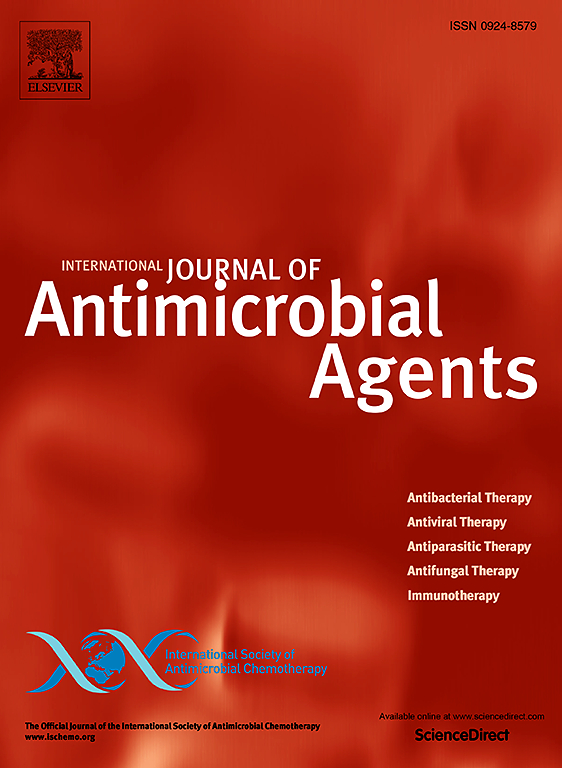Developing a human monoclonal antibody combination CRM25 to prevent rabies after exposure
IF 4.9
2区 医学
Q1 INFECTIOUS DISEASES
International Journal of Antimicrobial Agents
Pub Date : 2024-12-01
DOI:10.1016/j.ijantimicag.2024.107383
引用次数: 0
Abstract
Objective
Immunization against rabies post-exposure prophylaxis requires passive immunization with either monoclonal antibody (mAb) or blood-derived rabies immunoglobin (RIG). Currently, replacing traditional RIG with emerging mAb or mAb combinations is highly recommended due to the limited supply and potential safety risks of RIG.
Methods
We developed a mAb combination named CRM25 by combining two human mAbs, RM02 and RM05, at a 1:1 mass ratio.
Results
RM02 and RM05 were non-competing and non-overlapping mAbs targeting epitopes I and III, respectively. K226 and G229 were found to be the critical amino acid sites for RM02 neutralization, but the mutant I338T displayed decreased susceptibility to RM05 neutralization. Notably, CRM25 was capable of cross-neutralizing rabies virus (RABV) strains containing K226M or I338T mutations. CRM25 additionally showed an inhibitory effect on the infection of all tested common RABVs and non-RABV phylogroup I lyssaviruses. CRM25 not only exhibited neutralizing activity but also exhibited antiviral effects via Fc-mediated effector functions. Importantly, CRM25 was comparable to human RIG in terms of its capacity to protect Syrian golden hamsters from lethal RABV challenges.
Conclusions
These findings promote more thorough research on CRM25’s antiviral properties in cells and in vivo to enhance its clinical applicability and suggest that it may be a viable candidate medication for rabies post-exposure prophylaxis.

开发人类单克隆抗体组合 CRM25,预防狂犬病暴露后感染。
狂犬病暴露后预防(PEP)免疫需要使用单克隆抗体(mAb)或血源性狂犬病免疫球蛋白(RIG)进行被动免疫。目前,由于 RIG 的供应有限且存在潜在的安全风险,我们强烈建议使用新兴的 mAb 或 mAb 复合物取代传统的 RIG。在此,我们将两种人类 mAb(RM02 和 RM05)以 1:1 的质量比组合在一起,开发出了一种 mAb 组合,命名为 CRM25。RM02 和 RM05 是非竞争性和非重叠性 mAb,分别靶向表位 I 和 III。研究发现,K226 和 G229 是 RM02 中和的关键氨基酸位点,但突变体 I338T 对 RM05 中和的敏感性降低。值得注意的是,CRM25能够交叉中和含有K226M或I338T突变的狂犬病毒(RABV)株。此外,CRM25 还对所有测试过的普通 RABV 和非 RABV 系统组 I lyssaviruses 的感染有抑制作用。CRM25 不仅具有中和活性,还能通过 Fc 介导的效应器功能发挥抗病毒作用。重要的是,在保护叙利亚金色仓鼠免受致命的 RABV 病毒挑战方面,CRM25 的能力与人类 RIG 相当。这些发现促进了对CRM25在细胞和体内抗病毒特性的更深入研究,以提高其临床适用性,并表明它可能是狂犬病PEP的可行候选药物。
本文章由计算机程序翻译,如有差异,请以英文原文为准。
求助全文
约1分钟内获得全文
求助全文
来源期刊
CiteScore
21.60
自引率
0.90%
发文量
176
审稿时长
36 days
期刊介绍:
The International Journal of Antimicrobial Agents is a peer-reviewed publication offering comprehensive and current reference information on the physical, pharmacological, in vitro, and clinical properties of individual antimicrobial agents, covering antiviral, antiparasitic, antibacterial, and antifungal agents. The journal not only communicates new trends and developments through authoritative review articles but also addresses the critical issue of antimicrobial resistance, both in hospital and community settings. Published content includes solicited reviews by leading experts and high-quality original research papers in the specified fields.

 求助内容:
求助内容: 应助结果提醒方式:
应助结果提醒方式:


